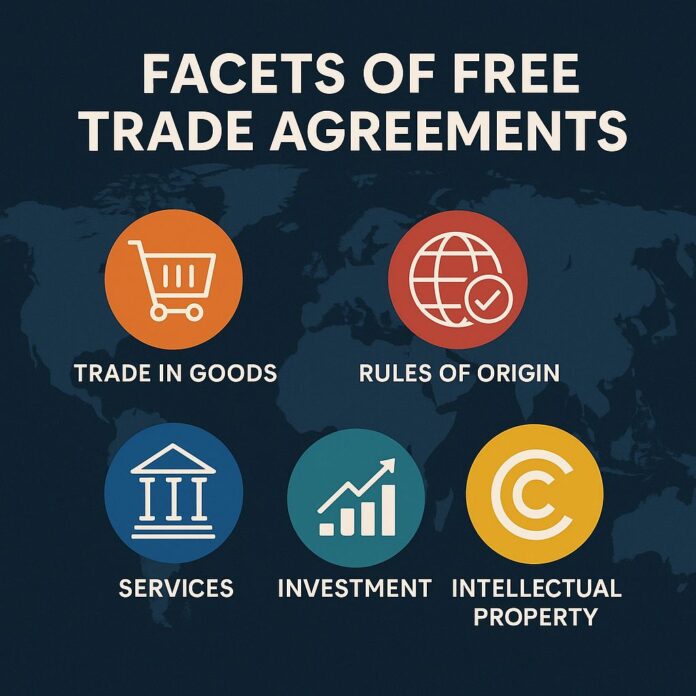BY: Kailash Chandra Agrawal and Keshav Shrivastava
Free Trade Agreements (FTAs) are legally binding treaties between two or more countries aimed at liberalizing trade by reducing or eliminating tariffs and other trade barriers on goods. In many cases, FTAs also include provisions on services, investment, intellectual property rights (IPR), standards, and more.
FTAs can take two primary forms: bilateral agreements (between two countries) and multilateral agreements (among several countries or economic blocs). When an FTA covers a wide spectrum of areas such as goods, services, investment, IPR, and technical standards, it is termed as a “comprehensive” agreement.
The scope of tariff concessions under an FTA may include zero-duty access on specific products, tariff reductions on others, and tariff-rate quotas (TRQs), which permit a limited quantity of imports at reduced duties. These concessions are typically structured within the “Trade in Goods” chapter of an FTA, along with detailed annexes listing individual products.
The core aim of any FTA is to enhance market access for exporters while striving to maintain balanced trade. According to India’s Ministry of Commerce, the country’s merchandise exports have shown significant growth post-FTA implementation. For example, exports to ASEAN increased from \$34.5 billion in 2011 to \$40.6 billion in 2021 after the India-ASEAN FTA.
However, successful FTA negotiation requires a deep understanding of domestic value chains and effective tariff structures. Policymakers must ensure that inputs are not taxed more heavily than finished goods, as this could create inverted duty structures that harm domestic industries. This analysis relies on data about domestic production and capacity, current demand and supply chains, trade flows, and the strategic importance of sectors and investment plans.
One of the critical features of an FTA is the Rules of Origin (ROO), which determine when a product qualifies as originating from a partner country and is thus eligible for preferential treatment. ROO can be based on wholly obtained criteria (e.g., mined or harvested within the country), change in tariff classification, or regional value content (RVC)—a minimum percentage of local inputs. Creating product-specific ROOs involves balancing the need to promote domestic processing and prevent trade deflection.
Liberalization strategies under FTAs can follow different approaches. A Positive List approach means only the sectors specifically mentioned are liberalized. In contrast, a Negative List approach assumes all sectors are liberalized by default except those explicitly excluded. Developing country FTAs, such as Comprehensive Economic Cooperation Agreements (CECA) or Comprehensive Economic Partnership Agreements (CEPA), often apply a hybrid model combining both methods.
India has signed FTAs with several key partners, including ASEAN, Japan, South Korea, Mauritius, the United Arab Emirates (UAE), and Australia. Additionally, India has recently finalized the India-UK Comprehensive Economic and Trade Agreement (CETA) and is currently negotiating FTAs with the European Union (EU), the United States, New Zealand, and the Gulf Cooperation Council (GCC).
Each FTA must be strategically tailored to suit mutual interests. For instance, the India-UAE CEPA was negotiated in just 88 days, showcasing rapid coordination. In contrast, the India-UK CETA took over three years of intense negotiations, reflecting the complexity of comprehensive agreements that include chapters on digital trade, services, investment, and more.
This book serves as a comprehensive global reference, with a strong focus on India’s evolving FTA landscape. It addresses foundational concepts such as what FTAs are and why they matter, explores technical aspects like HS tariff structures, origin rules, and TRQs, and discusses strategic considerations related to domestic impact, market access, and negotiation tactics. Every chapter is grounded in real-world examples, citing authoritative sources such as the World Trade Organization (WTO), World Customs Organization (WCO), and official trade ministries. The aim is to provide both a conceptual foundation and a practical toolkit for understanding and analyzing modern FTAs from an Indian and global perspective.
Facets for Free Trade Agreements BOOK by kca and ks (1)We wholeheartedly welcome feedback, professional inquiries, and collaboration opportunities from readers, policymakers, industry representatives, and academic institutions. Please reach out to:
-
Kailash Chandra Agrawal
Technical Consultant
Email: kc.agrawal01@gmail.com
Mobile: +91 98684 37079
LinkedIn: linkedin.com/in/kc-agrawal-710971371 -
Keshav Shrivastava
Public Policy | Trade & Investment Promotion Specialist
Email: keshav14shrivastava@gmail.com
Mobile: +91 93400 36062
LinkedIn: linkedin.com/in/keshav-shrivastava-957519190
Website: iimb.ac.in/keshav-shrivastava
Blog: keshavshrivastava.wordpress.com
Thank you for reading this book. We hope it serves as a valued resource in your professional journey.



